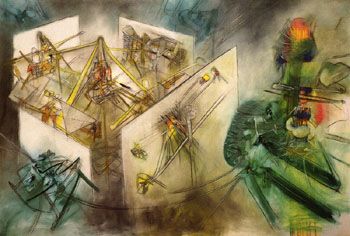Sarah Westlake: Drawings ↔ Sculpture
June 14–August 29, 2004
For a biography of Sara Westlake, click here.
Sarah Westlake was one of a handful of female artists of her generation from the Boston area who had an accomplished professional career. Coming of age as an artist during the 1940s and 1950s, she entered the cerebral, male-dominated world of abstract art. Abstraction became the ultimate expression of her knowledge and experience. Westlake synthesized the structural elements found in the minimal work of Agnes Martin, the decorative aspects of Henri Matisse, the flat space of Japanese prints and painted screens, and the aesthetics of gardens. Like haiku, her work evokes a dynamic tension between unruly, natural forms and planar structures.
To view selected works from the exhibition, click here.
This exhibition of twenty-six drawings, sculptures, and folding screens examines Westlake’s mature oeuvre. Between 1984 and 2002, Westlake alternated producing works in two and three dimensions which, when viewed together, approximate a graphic depiction of her creative process. An illustrated catalogue, with essays by co-curators Alston Conley and Mary Armstrong, accompanies this exhibition. Organized by the McMullen Museum, this exhibition has been underwritten by Boston College with major support from the Patrons of the McMullen Museum of Art.

Collection of Thomas Monahan
Exhibition
The exhibition will be installed chronologically, beginning with the artist’s well known European period in the late 1930s. This first section will highlight morphological works and will investigate how Matta grappled with the psyche and invented a visual language to evoke the subconscious. The second section focuses on Matta’s time in New York City, demonstrating the artist’s shift from personal psychological “inscapes” to external landscapes.
Also examined in this section is how Matta reorients his iconography in response to the horrors of World War II, by placing more emphasis on the figure. Drawings and paintings of his next creative phase, filled with humanoids and totemic beings, exemplify Matta’s growing concern with the universal human condition rather than his own psyche. The exhibition will demonstrate how this “universalism” serves as a transition to the artist’s fourth period, the 1950s, in which he incorporates figures in a geometric and planar space.
The last two sections of Making the Invisible Visible will exhibit fifteen works created during the last thirty-years of the artist’s life–a less studied and exhibited group. This section will critically explore the correlations between the artist’s pre- and post-war works and how they visualize his intense political beliefs, his ongoing fascination with the sciences, his dissatisfaction with the art market, and his revolutionary ideologies concerning the state of the world. Matta’s paintings of the 1960s and 70s appear as swirling futuristic forms. His final creative period in the 1980s and 90s reveals an artist that has come full circle, placing a mystical spin on his concern for humanity.
